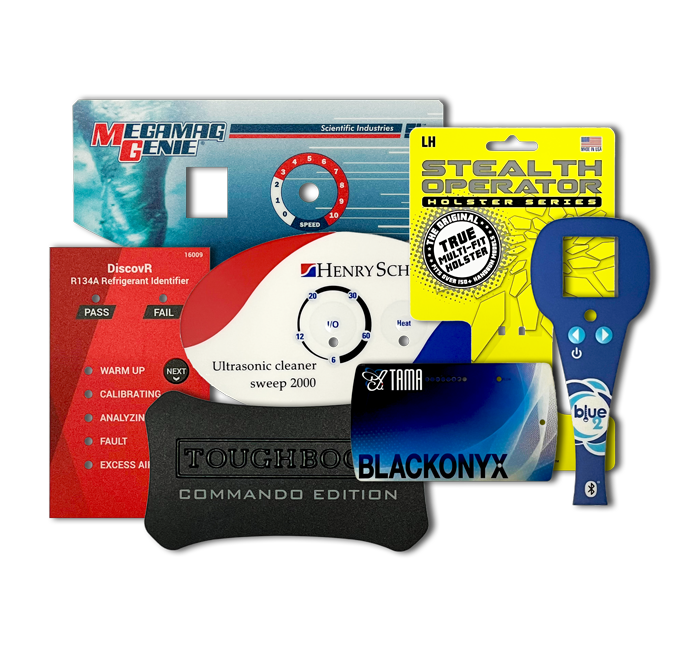How Shatterproof and Abrasion-Resistant Graphic Overlays Improve Lifespan
How Shatterproof and Abrasion-Resistant Graphic Overlays Improve Lifespan
Blog Article
Comprehending Exactly How Graphic Overlays Work to Boost Your Creative Jobs
Graphic overlays offer as an essential element in the realm of innovative projects, boosting both visual communication and target market involvement. The effective assimilation of these overlays needs cautious consideration of design concepts and goals.
What Are Graphic Overlays?
Graphic overlays are aesthetic aspects that are put on top of a base picture or user interface to improve interaction and user experience. They serve numerous purposes, including supplying additional information, assisting customer communication, and improving aesthetic charm. Typical applications of visuals overlays can be located in digital interfaces, advertising, and educational materials.

Graphic overlays are usually developed making use of design software, allowing developers to manipulate openness, shade, and dimension to attain the wanted effect. They can be dynamic or static, with animations that draw the audience's eye and improve engagement. The strategic use graphic overlays not only improves visual pecking order however additionally help in providing a clear and meaningful message. Thus, recognizing how to successfully implement graphic overlays is crucial for developers aiming to boost their creative projects.

Advantages of Utilizing Graphic Overlays
Making use of graphic overlays can significantly enhance the performance of aesthetic communication across numerous mediums. One of the key benefits is the capability to share complex info succinctly. By layering graphics, message, and pictures, overlays promote the presentation of data in a much more absorbable layout, making it less complicated for target markets to grasp crucial principles promptly.
Moreover, visuals overlays can enhance aesthetic appeal, accentuating particular aspects within a layout. This is particularly beneficial in marketing and advertising, where capturing the customer's rate of interest is extremely important. The strategic use colors, shapes, and typography in overlays can produce a interesting and natural aesthetic story, enhancing brand recognition.
Furthermore, visuals overlays supply adaptability in layout. They allow developers to adapt material for different systems without beginning from scratch, making sure consistency throughout numerous networks. This adaptability is vital in today's electronic landscape, where content must be optimized for diverse gadgets and formats.
Types of Graphic Overlays
When considering the different kinds of graphic overlays, it is important to acknowledge their diverse applications throughout different industries. Graphic overlays can be classified largely right content into three types: functional, decorative, and informational.
Functional overlays are designed to improve the usability of an item. Generally located in electronic tools, these overlays usually supply tactile feedback with increased buttons or distinctive surfaces, boosting individual communication. They can also function see this site as a protective layer, protecting the underlying parts from damage.
Ornamental overlays concentrate on aesthetic enhancement, allowing brand names to share their identification through dynamic layouts and personalized graphics. These overlays are prevalent in packaging, advertising and marketing, and point-of-sale materials, where aesthetic appeal is crucial for drawing in customers.
Informational overlays, on the other hand, are made use of to communicate important data or instructions. They can be seen in applications such as signs, user guidebooks, and instructional graphics, where clearness and readability are paramount.
Each sort of graphic overlay offers a distinct function, adding to the general effectiveness of innovative projects while resolving certain demands within different sectors. Understanding these differences is vital for picking the right overlay for your project.
Finest Practices for Implementation
To make sure the successful application of visuals overlays, it is crucial to establish a clear understanding of the project's objectives and the details requirements of the end-users. Begin by performing thorough research to identify the target audience and their preferences, as this will educate layout selections and capability.
Following, develop a thorough plan that details the overlay's assimilation, design, and function process. This plan needs to consist of individual interface considerations, guaranteeing that overlays enhance instead of block the user experience - Graphic Overlays. Keep and take into consideration the visual hierarchy consistency in design components, such as shade schemes, typefaces, and icons, to advertise brand coherence
Evaluating is crucial; collect feedback from a depictive example of individuals to recognize potential concerns and areas for renovation. Repeat on the design based upon individual input and performance data. Additionally, make certain compatibility across various gadgets and platforms to maximize availability.
Tools for Producing Overlays
Creating efficient graphic overlays needs use this link the right devices to translate layout concepts right into functional applications. Different software program and systems are readily available, each customized to particular needs and ability levels.
Adobe Photoshop and Illustrator are sector criteria, using substantial capabilities for producing and adjusting overlays. These tools give advanced features such as layer administration, mixing settings, and vector graphics, allowing developers to develop intricate and high-grade overlays.
For those seeking a much more user-friendly method, Canva and Figma are exceptional choices (Graphic Overlays). Canva's intuitive interface enables individuals to produce overlays promptly using pre-designed design templates, while Figma promotes collaborative design in real-time, making it excellent for teams
Furthermore, open-source choices like GIMP and Inkscape supply durable capabilities without the associated expenses of exclusive software application. These devices enable adaptability in layout and can suit numerous file styles, ensuring compatibility across various platforms.

Final Thought
In final thought, graphic overlays offer as powerful devices for improving innovative projects by offering aesthetic clearness, aesthetic allure, and brand consistency. By recognizing the essential principles and advantages associated with visuals overlays, designers can substantially improve the top quality and efficiency of their aesthetic interactions.
Graphic overlays serve as a pivotal part in the realm of imaginative jobs, boosting both aesthetic communication and audience interaction.Graphic overlays are typically developed utilizing design software program, allowing developers to adjust dimension, openness, and color to accomplish the desired impact.Moreover, visuals overlays can improve aesthetic charm, attracting attention to certain elements within a design.Furthermore, graphic overlays supply flexibility in layout.In verdict, visuals overlays serve as powerful tools for enhancing creative jobs by providing visual quality, aesthetic charm, and brand name uniformity.
Report this page